Monotheism
Monotheism is the belief in one god.[1][2][3][4] A narrower definition of monotheism is the belief in the existence of only one god that created the world, is omnipotent, omnipresent and omniscient, and intervenes in the world.[5][6][7]
| Part of a series on |
| God |
|---|
|
General conceptions |
|
In particular religions |
|
|
Related topics |
A distinction may be made between exclusive monotheism, and both inclusive monotheism and pluriform (panentheistic) monotheism which, while recognising various distinct gods, postulate some underlying unity.[1]
Monotheism is distinguished from henotheism, a religious system in which the believer worships one god without denying that others may worship different gods with equal validity, and monolatrism, the recognition of the existence of many gods but with the consistent worship of only one deity.[8] The term "monolatry" was perhaps first used by Julius Wellhausen.[9]
The broader definition of monotheism characterizes the traditions of Bábism, the Baháʼí Faith, Balinese Hinduism, Cao Dai (Caodaiism), Cheondoism (Cheondogyo), Christianity,[10] Deism, Druze faith,[11] Eckankar, Hindu sects such as Shaivism and Vaishnavism, Islam, Judaism, Mandaeism, Rastafari, Seicho no Ie, Sikhism, Tengrism (Tangrism), Tenrikyo (Tenriism), Yazidism, and Zoroastrianism, and elements of pre-monotheistic thought are found in early religions such as Atenism, ancient Chinese religion, and Yahwism.[1][12]
Etymology
The word monotheism comes from the Greek μόνος (monos)[13] meaning "single" and θεός (theos)[14] meaning "god".[15] The English term was first used by Henry More (1614–1687).[16]
Origins
Quasi-monotheistic claims of the existence of a universal deity date to the Late Bronze Age, with Akhenaten's Great Hymn to the Aten. A possible inclination towards monotheism emerged during the Vedic period[17] in Iron-Age South Asia. The Rigveda exhibits notions of monism of the Brahman, particularly in the comparatively late tenth book,[18] which is dated to the early Iron Age, e.g. in the Nasadiya sukta.
Since the sixth century BCE, Zoroastrians have believed in the supremacy of one God above all: Ahura Mazda as the "Maker of All"[19] and the first being before all others.[20][21][22][23] Nonetheless, Zoroastrianism was not strictly monotheistic[24] because it venerated other yazatas alongside Ahura Mazda. Ancient Hindu theology, meanwhile, was monist, but was not strictly monotheistic in worship because it still maintained the existence of many gods, who were envisioned as aspects of one supreme God, Brahman.[25] Numerous ancient Greek philosophers, including Xenophanes of Colophon and Antisthenes believed in a similar polytheistic monism that bore some similarities to monotheism.[25] Judaism was the first religion to conceive the notion of a personal monotheistic God within a monist context.[25] The concept of ethical monotheism, which holds that morality stems from God alone and that its laws are unchanging,[26][27] first occurred in Judaism,[28] but is now a core tenet of most modern monotheistic religions, including Zoroastrianism, Christianity, Islam, Sikhism, and Baháʼí Faith.[29]
According to Jewish, Christian and Islamic tradition, monotheism was the original religion of humanity; this original religion is sometimes referred to as "the Adamic religion", or, in the terms of Andrew Lang, the "Urreligion". Scholars of religion largely abandoned that view in the 19th century in favour of an evolutionary progression from animism via polytheism to monotheism, but by 1974 this theory was less widely held, and a modified view similar to Lang's became more prominent.[6] Austrian anthropologist Wilhelm Schmidt had postulated an Urmonotheismus, "original" or "primitive monotheism" in the 1910s.[30] It was objected that Judaism, Christianity, and Islam had grown up in opposition to polytheism as had Greek philosophical monotheism.[6] More recently, Karen Armstrong[31] and other authors have returned to the idea of an evolutionary progression beginning with animism, which developed into polytheism, which developed into henotheism, which developed into monolatry, which developed into true monotheism.[32]
Abrahamic religions
While all adherents of the Abrahamic religions consider themselves to be monotheists, some in Judaism do not consider Christianity to be a pure form of monotheism (due to the Christian doctrine of the Trinity), classifying it as Shituf.[33][34] Islam likewise does not recognize modern-day Christianity as monotheistic, primarily due to the Christian doctrine of Trinity, which Islam argues was not a part of the original monotheistic Christianity as preached by Jesus.[35] Christians, on the other hand, argue that the doctrine of the Trinity is a valid expression of monotheism, citing that the Trinity does not consist of three separate deities, but rather the three persons, who exist consubstantially (as one substance) within a single Godhead.[36][37][38]
Judaism

Judaism is traditionally considered one of the oldest monotheistic religions in the world,[39] although it is also believed that the earliest Israelites (pre-7th century BCE) were polytheistic,[40] evolved into henotheistic and later monolatristic,[41] rather than monotheistic. God in later Judaism was strictly monotheistic,[42] an absolute one, indivisible, and incomparable being who is the ultimate cause of all existence. The Babylonian Talmud references other, "foreign gods" as non-existent entities to whom humans mistakenly ascribe reality and power.[43] One of the best-known statements of Rabbinical Judaism on monotheism is the Second of Maimonides' 13 Principles of faith:
God, the Cause of all, is one. This does not mean one as in one of a pair, nor one like a species (which encompasses many individuals), nor one as in an object that is made up of many elements, nor as a single simple object that is infinitely divisible. Rather, God is a unity unlike any other possible unity.[44]
Some in Judaism[45] and Islam reject the Christian idea of monotheism. Judaism uses the term shituf to refer to the worship of God in a manner which Judaism deems to be neither purely monotheistic (though still permissible for non-Jews) nor polytheistic (which would be prohibited).[34]
In Ancient Israel
During the 8th century BCE, the worship of Yahweh in Israel was in competition with many other cults, described by the Yahwist faction collectively as Baals. The oldest books of the Hebrew Bible reflect this competition, as in the books of Hosea and Nahum, whose authors lament the "apostasy" of the people of Israel, threatening them with the wrath of God if they do not give up their polytheistic cults.[46][47]
Ancient Israelite religion was originally polytheistic;[40] the Israelites worshipped many deities,[48] including El, Baal, Asherah, and Astarte. Yahweh was originally the national god of the Kingdom of Israel and the Kingdom of Judah.[48] As time progressed, the henotheistic cult of Yahweh grew increasingly militant in its opposition to the worship of other gods.[40] Later, the reforms of King Josiah imposed a form of strict Israeli monolatrism. After the fall of Judah and the beginning of the Babylonian captivity, a small circle of priests and scribes gathered around the exiled royal court, where they first developed the concept of Yahweh as the sole God of the world.[25]
The Shema
Shema Yisrael ("Hear, [O] Israel") are the first two words of a section of the Torah, and is the title of a prayer that serves as a centerpiece of the morning and evening Jewish prayer services. The first verse encapsulates the monotheistic essence of Judaism: "Hear, O Israel: the LORD our God, the LORD is one" (Hebrew: שְׁמַע יִשְׂרָאֵל ה' אֱלֹהֵינוּ ה' אֶחָד), found in Deuteronomy 6:4, sometimes alternatively translated as "The LORD is our God, the LORD alone". Observant Jews consider the Shema to be the most important part of the prayer service in Judaism, and its twice-daily recitation as a mitzvah (religious commandment). It is traditional for Jews to say the Shema as their last words, and for parents to teach their children to say it before they go to sleep at night.
Christianity
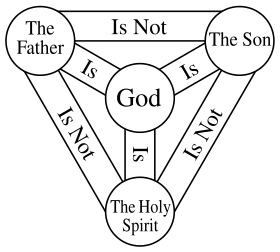
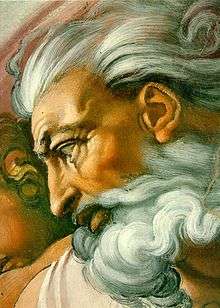
Among early Christians there was considerable debate over the nature of the Godhead, with some denying the incarnation but not the deity of Jesus (Docetism) and others later calling for an Arian conception of God. Despite at least one earlier local synod rejecting the claim of Arius, this Christological issue was to be one of the items addressed at the First Council of Nicaea.
The First Council of Nicaea, held in Nicaea (in present-day Turkey), convoked by the Roman Emperor Constantine I in 325, was the first ecumenical[50] council of bishops of the Roman Empire, and most significantly resulted in the first uniform Christian doctrine, called the Nicene Creed. With the creation of the creed, a precedent was established for subsequent general ecumenical councils of bishops (synods) to create statements of belief and canons of doctrinal orthodoxy— the intent being to define a common creed for the Church and address heretical ideas.
One purpose of the council was to resolve disagreements in Alexandria over the nature of Jesus in relationship to the Father; in particular, whether Jesus was of the same substance as God the Father or merely of similar substance. All but two bishops took the first position; while Arius' argument failed.
Christian orthodox traditions (Eastern Orthodox, Oriental Orthodox, Roman Catholic, and most Protestants) follow this decision, which was reaffirmed in 381 at the First Council of Constantinople and reached its full development through the work of the Cappadocian Fathers. They consider God to be a triune entity, called the Trinity, comprising three "persons", God the Father, God the Son, and God the Holy Spirit. These three are described as being "of the same substance" (ὁμοούσιος).
Christians overwhelmingly assert that monotheism is central to the Christian faith, as the Nicene Creed (and others), which gives the orthodox Christian definition of the Trinity, begins: "I believe in one God". From earlier than the times of the Nicene Creed, 325 CE, various Christian figures advocated[51] the triune mystery-nature of God as a normative profession of faith. According to Roger E. Olson and Christopher Hall, through prayer, meditation, study and practice, the Christian community concluded "that God must exist as both a unity and trinity", codifying this in ecumenical council at the end of the 4th century.[52]
Most modern Christians believe the Godhead is triune, meaning that the three persons of the Trinity are in one union in which each person is also wholly God. They also hold to the doctrine of a man-god Christ Jesus as God incarnate. These Christians also do not believe that one of the three divine figures is God alone and the other two are not but that all three are mysteriously God and one. Other Christian religions, including Unitarian Universalism, Jehovah's Witnesses, Mormonism and others, do not share those views on the Trinity.
Some Christian faiths, such as Mormonism, argue that the Godhead is in fact three separate individuals which include God the Father, His Son Jesus Christ, and the Holy Ghost.[53] Each individual having a distinct purpose in the grand existence of human kind.[54] Furthermore, Mormons believe that before the Council of Nicaea, the predominant belief among many early Christians was that the Godhead was three separate individuals. In support of this view, they cite early Christian examples of belief in subordinationism.[55]
Unitarianism is a theological movement, named for its understanding of God as one person, in direct contrast to Trinitarianism.[56]
Islam

In Islam, God (Allāh) is all-powerful and all-knowing, the creator, sustainer, ordainer and judge of the universe.[57][58] God in Islam is strictly singular (tawhid)[59] unique (wahid) and inherently One (ahad), all-merciful and omnipotent.[60] Allāh exists without place[61] and the Qurʼan states that "No vision can grasp Him, but His grasp is over all vision. God is above all comprehension, yet is acquainted with all things" (Qurʼan 6:103)[58] Allāh is the only God and the same God worshiped in Christianity and Judaism. (29:46).[62]
Islam emerged in the 7th century CE in the context of both Christianity and Judaism, with some thematic elements similar to Gnosticism.[63][64][65][66][67][68][69][70] Islamic belief states that Muhammad did not bring a new religion from God, but is rather the same religion as practiced by Abraham, Moses, David, Jesus and all the other prophets of God.[71] The assertion of Islam is that the message of God had been corrupted, distorted or lost over time and the Quran was sent to Muhammad in order to correct the lost message of the Torah, New Testament and prior scriptures from God.[72]
The Qurʼan asserts the existence of a single and absolute truth that transcends the world; a unique and indivisible being who is independent of the creation.[73] The Qurʼan rejects binary modes of thinking such as the idea of a duality of God by arguing that both good and evil generate from God's creative act. God is a universal god rather than a local, tribal or parochial one; an absolute who integrates all affirmative values and brooks no evil.[74] Ash'ari theology, which dominated Sunni Islam from the tenth to the nineteenth century, insists on ultimate divine transcendence and holds that divine unity is not accessible to human reason. Ash'arism teaches that human knowledge regarding it is limited to what has been revealed through the prophets, and on such paradoxes as God's creation of evil, revelation had to accept bila kayfa (without [asking] how).[75]
Tawhid constitutes the foremost article of the Muslim profession of faith, "There is no god but God, Muhammad is the messenger of God.[76] To attribute divinity to a created entity is the only unpardonable sin mentioned in the Qurʼan.[74] The entirety of the Islamic teaching rests on the principle of tawhid.[77]
Medieval Islamic philosopher Al-Ghazali offered a proof of monotheism from omnipotence, asserting there can only be one omnipotent being. For if there were two omnipotent beings, the first would either have power over the second (meaning the second is not omnipotent) or not (meaning the first is not omnipotent); thus implying that there could only be one omnipotent being.[78]
As they traditionally profess a concept of monotheism with a singular person as God, Judaism[45] and Islam reject the Christian idea of monotheism. Judaism uses the term Shituf to refer to non-monotheistic ways of worshiping God. Although Muslims venerate Jesus (Isa in Arabic) as a prophet, they do not accept the doctrine that he was a begotten son of God.
Mandaeism

Mandaeism or Mandaeanism (Arabic: مندائية Mandāʼīyah) is a monotheistic Gnostic religion.[79]:4 Its adherents, the Mandaeans, revere Adam, Abel, Seth, Enos, Noah, Shem, Aram, and especially John the Baptist. The Mandaean God is named as Hayyi Rabbi meaning The Great Life or The Great Living God. The Mandaeans are Semites and speak a dialect of Eastern Aramaic known as Mandaic. The name 'Mandaean' is said to come from the Aramaic manda meaning "knowledge", as does Greek gnosis.[80][81] Within the Middle East, but outside of their community, the Mandaeans are more commonly known as the Ṣubba (singular: Ṣubbī) or Sabians. The term Ṣubba is derived from the Aramaic root related to baptism, the neo-Mandaic is Ṣabi.[82] In Islam, the "Sabians" (Arabic: الصابئون al-Ṣābiʾūn) are described several times in the Quran as People of the Book, alongside Jews and Christians.[83]
Baháʼí Faith

God in the Baháʼí Faith is taught to be a personal god, too great for humans to fully comprehend. Human primitive understanding of God is achieved through his revelations via his divine intermediary Manifestations.[84][85] In the Baháʼí faith, such Christian doctrines as the Trinity are seen as compromising the Baháʼí view that God is single and has no equal.[86] And the very existence of the Baháʼí Faith is a challenge to the Islamic doctrine of the finality of Muhammad's revelation.[87] God in the Baháʼí Faith communicates to humanity through divine intermediaries, known as Manifestations of God.[88] These Manifestations establish religion in the world.[85] It is through these divine intermediaries that humans can approach God, and through them God brings divine revelation and law.[89]
The Oneness of God is one of the core teachings of the Baháʼí Faith. The obligatory prayers in the Baháʼí Faith involve explicit monotheistic testimony.[90][91] God is the imperishable, uncreated being who is the source of all existence.[92] He is described as "a personal God, unknowable, inaccessible, the source of all Revelation, eternal, omniscient, omnipresent and almighty".[93][94] Although transcendent and inaccessible directly, his image is reflected in his creation. The purpose of creation is for the created to have the capacity to know and love its creator.[95] God communicates his will and purpose to humanity through intermediaries, known as Manifestations of God, who are the prophets and messengers that have founded religions from prehistoric times up to the present day.[88]
Rastafari
Rastafari, sometimes termed Rastafarianism, is classified as both a new religious movement and social movement. It developed in Jamaica during the 1930s. It lacks any centralised authority and there is much heterogeneity among practitioners, who are known as Rastafari, Rastafarians, or Rastas.
Rastafari refer to their beliefs, which are based on a specific interpretation of the Bible, as "Rastalogy". Central is a monotheistic belief in a single God—referred to as Jah—who partially resides within each individual. The former emperor of Ethiopia, Haile Selassie, is given central importance. Many Rastas regard him as an incarnation of Jah on Earth and as the Second Coming of Christ. Others regard him as a human prophet who fully recognised the inner divinity within every individual.
Atenism
_(Mus%C3%A9e_du_Caire)_(2076972086).jpg)
Amenhotep IV initially introduced Atenism in Year 5 of his reign (1348/1346 BCE) during the 18th dynasty of the New Kingdom. He raised Aten, once a relatively obscure Egyptian Solar deity representing the disk of the sun, to the status of Supreme God in the Egyptian pantheon.[96] To emphasise the change, Aten's name was written in the cartouche form normally reserved for Pharaohs, an innovation of Atenism. This religious reformation appears to coincide with the proclamation of a Sed festival, a sort of royal jubilee intended to reinforce the Pharaoh's divine powers of kingship. Traditionally held in the thirtieth year of the Pharaoh's reign, this possibly was a festival in honour of Amenhotep III, who some Egyptologists think had a coregency with his son Amenhotep IV of two to twelve years.
Year 5 is believed to mark the beginning of Amenhotep IV's construction of a new capital, Akhetaten (Horizon of the Aten), at the site known today as Amarna.[97] Evidence of this appears on three of the boundary stelae used to mark the boundaries of this new capital. At this time, Amenhotep IV officially changed his name to Akhenaten (Agreeable to Aten) as evidence of his new worship. The date given for the event has been estimated to fall around January 2 of that year. In Year 7 of his reign (1346/1344 BCE), the capital was moved from Thebes to Akhetaten (near modern Amarna), though construction of the city seems to have continued for two more years. In shifting his court from the traditional ceremonial centres Akhenaten was signalling a dramatic transformation in the focus of religious and political power.
The move separated the Pharaoh and his court from the influence of the priesthood and from the traditional centres of worship, but his decree had deeper religious significance too—taken in conjunction with his name change, it is possible that the move to Amarna was also meant as a signal of Akhenaten's symbolic death and rebirth. It may also have coincided with the death of his father and the end of the coregency. In addition to constructing a new capital in honor of Aten, Akhenaten also oversaw the construction of some of the most massive temple complexes in ancient Egypt, including one at Karnak and one at Thebes, close to the old temple of Amun.
In Year 9 (1344/1342 BCE), Akhenaten declared a more radical version of his new religion, declaring Aten not merely the supreme god of the Egyptian pantheon, but the only God of Egypt, with himself as the sole intermediary between the Aten and the Egyptian people. Key features of Atenism included a ban on idols and other images of the Aten, with the exception of a rayed solar disc, in which the rays (commonly depicted ending in hands) appear to represent the unseen spirit of Aten. Akhenaten made it however clear that the image of the Aten only represented the god, but that the god transcended creation and so could not be fully understood or represented.[98] Aten was addressed by Akhenaten in prayers, such as the Great Hymn to the Aten: "O Sole God beside whom there is none".
The details of Atenist theology are still unclear. The exclusion of all but one god and the prohibition of idols was a radical departure from Egyptian tradition, but scholars see Akhenaten as a practitioner of monolatry rather than monotheism, as he did not actively deny the existence of other gods; he simply refrained from worshiping any but Aten. Akhenaten associated Aten with Ra and put forward the eminence of Aten as the renewal of the kingship of Ra.[99]
Under Akhenaten's successors, Egypt reverted to its traditional religion, and Akhenaten himself came to be reviled as a heretic.
Chinese view

The orthodox faith system held by most dynasties of China since at least the Shang Dynasty (1766 BCE) until the modern period centered on the worship of Shangdi (literally "Above Sovereign", generally translated as "God") or Heaven as an omnipotent force.[100] This faith system pre-dated the development of Confucianism and Taoism and the introduction of Buddhism and Christianity. It has features of monotheism in that Heaven is seen as an omnipotent entity, a noncorporeal force with a personality transcending the world. From the writings of Confucius in the Analects, it is known Confucius believed that Heaven cannot be deceived, Heaven guides people's lives and maintains a personal relationship with them, and that Heaven gives tasks for people to fulfill in order to teach them of virtues and morality.[100] However, this faith system was not truly monotheistic since other lesser gods and spirits, which varied with locality, were also worshiped along with Shangdi. Still, later variants such as Mohism (470 BCE–c.391 BCE) approached true monotheism, teaching that the function of lesser gods and ancestral spirits is merely to carry out the will of Shangdi, akin to the angels in Abrahamic religions which in turn counts as only one god. In Mozi's Will of Heaven (天志), he writes:
Will of Heaven, Chapter 27, Paragraph 6, ca. 5th century BCE
Worship of Shangdi and Heaven in ancient China includes the erection of shrines, the last and greatest being the Temple of Heaven in Beijing, and the offering of prayers. The ruler of China in every Chinese dynasty would perform annual sacrificial rituals to Shangdi, usually by slaughtering a completely healthy bull as sacrifice. Although its popularity gradually diminished after the advent of Taoism and Buddhism, among other religions, its concepts remained in use throughout the pre-modern period and have been incorporated in later religions in China, including terminology used by early Christians in China. Despite the rising of non-theistic and pantheistic spirituality contributed by Taoism and Buddhism, Shangdi was still praised up until the end of the Qing Dynasty as the last ruler of the Qing declared himself son of heaven.
Indigenous African religion
The Himba people of Namibia practice a form of monotheistic panentheism, and worship the god Mukuru. The deceased ancestors of the Himba and Herero are subservient to him, acting as intermediaries.[101]
The Igbo people practice a form of monotheism called Odinani.[102] Odinani has monotheistic and panentheistic attributes, having a single God as the source of all things. Although a pantheon of spirits exists, these are lesser spirits prevalent in Odinani expressly serving as elements of Chineke (or Chukwu), the supreme being or high god.
Waaq is the name of a singular God in the traditional religion of many Cushitic people in the Horn of Africa, denoting an early monotheistic religion. However this religion was mostly replaced with the Abrahamic religions. Some (approximately 3%) of Oromo still follow this traditional monotheistic religion called Waaqeffannaa in Oromo.
Indo-European religions
Proto-Indo-European religion
The supreme god of the Proto-Indo-European religion was the god *Dyḗus Pḥatḗr . A number of words derived from the name of this supreme deity are used in various Indo-European languages to denote a monotheistic God. Nonetheless, in spite of this, Proto-Indo-European religion itself was not monotheistic.[103]
In western Eurasia, the ancient traditions of the Slavic religion contained elements of monotheism. In the sixth century AD, the Byzantine chronicler Procopius recorded that the Slavs "acknowledge that one god, creator of lightning, is the only lord of all: to him do they sacrifice an ox and all sacrificial animals."[104] The deity to whom Procopius is referring is the storm god Perún, whose name is derived from *Perkwunos, the Proto-Indo-European god of lightning. The ancient Slavs syncretized him with the Germanic god Thor and the Biblical prophet Elijah.[105]
Indo-Iranian religions
Hinduism
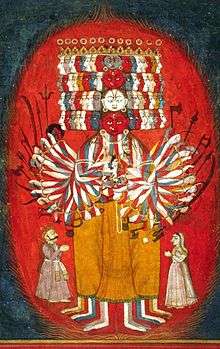
As an old religion, Hinduism inherits religious concepts spanning monotheism, polytheism, panentheism, pantheism, monism, and atheism among others;[106][107][108][109] and its concept of God is complex and depends upon each individual and the tradition and philosophy followed.
Hindu views are broad and range from monism, through pantheism and panentheism (alternatively called monistic theism by some scholars) to monotheism and even atheism. Hinduism cannot be said to be purely polytheistic. Hindu religious leaders have repeatedly stressed that while God's forms are many and the ways to communicate with him are many, God is one. The puja of the murti is a way to communicate with the abstract one god (Brahman) which creates, sustains and dissolves creation.[110]
Rig Veda 1.164.46,
- Indraṃ mitraṃ varuṇamaghnimāhuratho divyaḥ sa suparṇo gharutmān,
- ekaṃ sad viprā bahudhā vadantyaghniṃ yamaṃ mātariśvānamāhuḥ
- "They call him Indra, Mitra, Varuṇa, Agni, and he is heavenly nobly-winged Garuda.
- To what is One, sages give many a title they call it Agni, Yama, Mātariśvan." (trans. Griffith)
Traditions of Gaudiya Vaishnavas, the Nimbarka Sampradaya and followers of Swaminarayan and Vallabha consider Krishna to be the source of all avatars,[111] and the source of Vishnu himself, or to be the same as Narayana. As such, he is therefore regarded as Svayam Bhagavan.[112][113][114]
When Krishna is recognized to be Svayam Bhagavan, it can be understood that this is the belief of Gaudiya Vaishnavism,[115] the Vallabha Sampradaya,[116] and the Nimbarka Sampradaya, where Krishna is accepted to be the source of all other avatars, and the source of Vishnu himself. This belief is drawn primarily "from the famous statement of the Bhagavatam"[117] (1.3.28).[118] A viewpoint differing from this theological concept is the concept of Krishna as an avatar of Narayana or Vishnu. It should be however noted that although it is usual to speak of Vishnu as the source of the avataras, this is only one of the names of the God of Vaishnavism, who is also known as Narayana, Vasudeva and Krishna and behind each of those names there is a divine figure with attributed supremacy in Vaishnavism.[119]
The Rig Veda discusses monotheistic thought, as do the Atharva Veda and Yajur Veda: "Devas are always looking to the supreme abode of Vishnu" (tad viṣṇoḥ paramaṁ padaṁ sadā paśyanti sṻrayaḥ Rig Veda 1.22.20)
"The One Truth, sages know by many names" (Rig Veda 1.164.46)[120]
"When at first the unborn sprung into being, He won His own dominion beyond which nothing higher has been in existence" (Atharva Veda 10.7.31)[121]
"There is none to compare with Him. There is no parallel to Him, whose glory, verily, is great." (Yajur Veda 32.3)[122]
The number of auspicious qualities of God are countless, with the following six qualities (bhaga) being the most important:
- Jñāna (omniscience), defined as the power to know about all beings simultaneously
- Aishvarya (sovereignty, derived from the word Ishvara), which consists in unchallenged rule over all
- Shakti (energy), or power, which is the capacity to make the impossible possible
- Bala (strength), which is the capacity to support everything by will and without any fatigue
- Vīrya (vigor), which indicates the power to retain immateriality as the supreme being in spite of being the material cause of mutable creations
- Tejas (splendor), which expresses His self-sufficiency and the capacity to overpower everything by His spiritual effulgence[123]
In the Shaivite tradition, the Shri Rudram (Sanskrit श्रि रुद्रम्), to which the Chamakam (चमकम्) is added by scriptural tradition, is a Hindu stotra dedicated to Rudra (an epithet of Shiva), taken from the Yajurveda (TS 4.5, 4.7).[124][125] Shri Rudram is also known as Sri Rudraprasna, Śatarudrīya, and Rudradhyaya. The text is important in Vedanta where Shiva is equated to the Universal supreme God. The hymn is an early example of enumerating the names of a deity,[126] a tradition developed extensively in the sahasranama literature of Hinduism.
The Nyaya school of Hinduism has made several arguments regarding a monotheistic view. The Naiyanikas have given an argument that such a god can only be one. In the Nyaya Kusumanjali, this is discussed against the proposition of the Mimamsa school that let us assume there were many demigods (devas) and sages (rishis) in the beginning, who wrote the Vedas and created the world. Nyaya says that:
[If they assume such] omniscient beings, those endowed with the various superhuman faculties of assuming infinitesimal size, and so on, and capable of creating everything, then we reply that the law of parsimony bids us assume only one such, namely Him, the adorable Lord. There can be no confidence in a non-eternal and non-omniscient being, and hence it follows that according to the system which rejects God, the tradition of the Veda is simultaneously overthrown; there is no other way open.
In other words, Nyaya says that the polytheist would have to give elaborate proofs for the existence and origin of his several celestial spirits, none of which would be logical, and that it is more logical to assume one eternal, omniscient god.[127]
Sikhism
Sikhi is a monotheistic[128][129] and a revealed religion.[130] God in Sikhi is called by many names like Ram, Allah and Vāhigurū etc. but refer to same god, and is shapeless, timeless, and sightless: niraṅkār, akaal, and alakh. God is present (sarav viāpak) in all of creation. God must be seen from "the inward eye", or the "heart". Sikhi devotees must meditate to progress towards enlightenment, as its rigorous application permits the existence of communication between God and human beings.[131]
Sikhism is a monotheistic faith[132][133] that arose in northern India during the 16th and 17th centuries. Sikhs believe in one, timeless, omnipresent, supreme creator. The opening verse of the Guru Granth Sahib, known as the Mul Mantra, signifies this:
- Punjabi: ੴ ਸਤਿ ਨਾਮੁ ਕਰਤਾ ਪੁਰਖੁ ਨਿਰਭਉ ਨਿਰਵੈਰੁ ਅਕਾਲ ਮੂਰਤਿ ਅਜੂਨੀ ਸੈਭੰ ਗੁਰ ਪ੍ਰਸਾਦਿ ॥
- Transliteration: ikk ōankār sat(i)-nām(u) karatā purakh(u) nirabha'u niravair(u) akāla mūrat(i) ajūnī saibhan(g) gur(a) prasād(i).
- One Universal creator God, The supreme Unchangeable Truth, The Creator of the Universe, Beyond Fear, Beyond Hatred, Beyond Death, Beyond Birth, Self-Existent, by Guru's Grace.
The word "ੴ" ("Ik ōaṅkār") has two components. The first is ੧, the digit "1" in Gurmukhi signifying the singularity of the creator. Together the word means: "One Universal creator God".
It is often said that the 1430 pages of the Guru Granth Sahib are all expansions on the Mul Mantra. Although the Sikhs have many names for God, some derived from Islam and Hinduism, they all refer to the same Supreme Being.
The Sikh holy scriptures refer to the One God who pervades the whole of space and is the creator of all beings in the universe. The following quotation from the Guru Granth Sahib highlights this point:
"Chant, and meditate on the One God, who permeates and pervades the many beings of the whole Universe. God created it, and God spreads through it everywhere. Everywhere I look, I see God. The Perfect Lord is perfectly pervading and permeating the water, the land and the sky; there is no place without Him."
— Guru Granth Sahib, Page 782
However, there is a strong case for arguing that the Guru Granth Sahib teaches monism due to its non-dualistic tendencies:
Punjabi: ਸਹਸ ਪਦ ਬਿਮਲ ਨਨ ਏਕ ਪਦ ਗੰਧ ਬਿਨੁ ਸਹਸ ਤਵ ਗੰਧ ਇਵ ਚਲਤ ਮੋਹੀ ॥੨॥
"You have thousands of Lotus Feet, and yet You do not have even one foot. You have no nose, but you have thousands of noses. This Play of Yours entrances me."
— Guru Granth Sahib, Page 13
Sikhs believe that God has been given many names, but they all refer to the One God, VāhiGurū. Sikhs believe that members of other religions such as Islam, Hinduism and Christianity all worship the same God, and the names Allah, Rahim, Karim, Hari, Raam and Paarbrahm are frequently mentioned in the Sikh holy scriptures. Although there is no set reference to God in Sikhism, the most commonly used Sikh reference to God is Akal Purakh (which means "the true immortal") or Waheguru, the Primal Being.
Zoroastrianism

Zoroastrianism combines cosmogonic dualism and eschatological monotheism which makes it unique among the religions of the world. Zoroastrianism proclaims an evolution through time from dualism to monotheism.[134]
Zoroastrianism is a monotheistic religion,[135] although Zoroastrianism is often regarded[136] as dualistic, duotheistic or bitheistic, for its belief in the hypostatis of the ultimately good Ahura Mazda (creative spirit) and the ultimately evil Angra Mainyu (destructive spirit). Zoroastrianism was once one of the largest religions on Earth, as the official religion of the Persian Empire. By some scholars, the Zoroastrians ("Parsis" or "Zartoshtis") are credited with being some of the first monotheists and having had influence on other world religions. Gathered statistics shows the number of adherents at as many as 3.5 million,[137] with adherents living in many regions, including South Asia.
Ancient Greek religion
Classical Greece
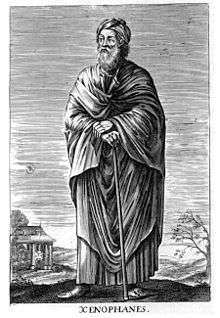
The surviving fragments of the poems of the classical Greek philosopher Xenophanes of Colophon suggest that he held views very similar to those of modern monotheists.[138] His poems harshly criticize the traditional notion of anthropomorphic gods, commenting that "...if cattle and horses and lions had hands or could paint with their hands and create works such as men do,... [they] also would depict the gods' shapes and make their bodies of such a sort as the form they themselves have."[139] Instead, Xenophanes declares that there is "...one god, greatest among gods and humans, like mortals neither in form nor in thought."[140] Xenophanes's theology appears to have been monist, but not truly monotheistic in the strictest sense.[25] Although some later philosophers, such as Antisthenes, believed in doctrines similar to those expounded by Xenophanes, his ideas do not appear to have become widely popular.[25]
Although Plato himself was a polytheist, in his writings, he often presents Socrates as speaking of "the god" in the singular form. He does, however, often speak of the gods in the plural form as well. The Euthyphro dilemma, for example, is formulated as "Is that which is holy loved by the gods because it is holy, or is it holy because it is loved by the gods?"[141]
Hellenistic Religion
The development of pure (philosophical) monotheism is a product of the Late Antiquity. During the 2nd to 3rd centuries, early Christianity was just one of several competing religious movements advocating monotheism.
"The One" (Τὸ Ἕν) is a concept that is prominent in the writings of the Neoplatonists, especially those of the philosopher Plotinus.[142] In the writings of Plotinus, "The One" is described as an inconceivable, transcendent, all-embodying, permanent, eternal, causative entity that permeates throughout all of existence.[143]
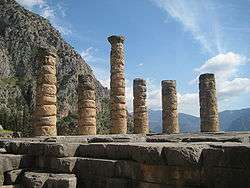
A number of oracles of Apollo from Didyma and Clarus, the so-called "theological oracles", dated to the 2nd and 3rd century CE, proclaim that there is only one highest god, of whom the gods of polytheistic religions are mere manifestations or servants.[144] 4th century CE Cyprus had, besides Christianity, an apparently monotheistic cult of Dionysus.[145]
The Hypsistarians were a religious group who believed in a most high god, according to Greek documents. Later revisions of this Hellenic religion were adjusted towards Monotheism as it gained consideration among a wider populace. The worship of Zeus as the head-god signaled a trend in the direction of monotheism, with less honour paid to the fragmented powers of the lesser gods.
New religious movements
Various New religious movements, such as Rastafari, Cao Đài, Tenrikyo, Seicho no Ie and Cheondoism are monotheistic.
Tengrism
Tengrism or Tangrism (sometimes stylized as Tengriism), occasionally referred to as Tengrianism , is a modern term[146] for a Central Asian religion characterized by features of shamanism, animism, totemism, both polytheism and monotheism,[147][148][149][150] and ancestor worship. Historically, it was the prevailing religion of the Bulgars, Turks, Mongols, and Hungarians, as well as the Xiongnu and the Huns.[151][152] It was the state religion of the six ancient Turkic states: Avar Khaganate, Old Great Bulgaria, First Bulgarian Empire, Göktürks Khaganate, Eastern Tourkia and Western Turkic Khaganate. In Irk Bitig, Tengri is mentioned as Türük Tängrisi (God of Turks).[153] The term is perceived among Turkic peoples as a national religion.
In Chinese and Turco-Mongol traditions, the Supreme God is commonly referred to as the ruler of Heaven, or the Sky Lord granted with omnipotent powers, but it has largely diminished in those regions due to ancestor worship, Taoism's pantheistic views and Buddhism's rejection of a creator God. On some occasions in the mythology, the Sky Lord as identified as a male has been associated to mate with an Earth Mother, while some traditions kept the omnipotence of the Sky Lord unshared.
Native American religion
Native American theology may be monotheistic, polytheistic, henotheistic, animistic, or some combination thereof.
Cherokee for example are monotheist as well as pantheist.
The Great Spirit, called Wakan Tanka among the Sioux,[154] and Gitche Manitou in Algonquian, is a conception of universal spiritual force, or supreme being prevalent among some Native American and First Nation cultures.[155] According to Lakota activist Russell Means a better translation of Wakan Tanka is the Great Mystery.[156]
Some researchers have interpreted Aztec philosophy as fundamentally monotheistic or panentheistic. While the populace at large believed in a polytheistic pantheon, Aztec priests and nobles might have come to an interpretation of Teotl as a single universal force with many facets.[157] There has been criticism to this idea, however, most notably that many assertions of this supposed monotheism might actually come from post-Conquistador bias, imposing an Antiquity pagan model unto the Aztec.[158]
See also
Notes
- "Monotheism". Encyclopædia Britannica.
- "monotheism". Oxford Dictionaries.
- "Monotheism". Merriam-Webster.
- "monotheism". Cambridge Dictionary.
- Monotheism. Hutchinson Encyclopedia (12th edition). p. 644.
- Cross, F.L.; Livingstone, E.A., eds. (1974). "Monotheism". The Oxford Dictionary of the Christian Church (2 ed.). Oxford: Oxford University Press.
- William Wainwright (2018). "Monotheism". Stanford Encyclopedia of Philosophy. Metaphysics Research Lab, Stanford University.
- Frank E. Eakin, Jr. The Religion and Culture of Israel (Boston: Allyn and Bacon, 1971), 70.
- Mackintosh, Robert (1916). "Monolatry and Henotheism". Encyclopedia of Religion and Ethics. VIII: 810. Retrieved Jan 21, 2016.
- Christianity's status as monotheistic is affirmed in, among other sources, the Catholic Encyclopedia (article "Monotheism"); William F. Albright, From the Stone Age to Christianity; H. Richard Niebuhr; About.com, Monotheistic Religion resources; Kirsch, God Against the Gods; Woodhead, An Introduction to Christianity; The Columbia Electronic Encyclopedia Monotheism; The New Dictionary of Cultural Literacy, monotheism; New Dictionary of Theology, Paul, pp. 496–499; Meconi. "Pagan Monotheism in Late Antiquity". pp. 111ff.
- Obeid, Anis (2006). The Druze & Their Faith in Tawhid. Syracuse University Press. p. 1. ISBN 978-0-8156-5257-1. Retrieved 27 May 2017.
- References:
- A Modern Hindu Monotheism: Indonesian Hindus as 'People of the Book'. The Journal of Hindu Studies, Oxford University Press, June McDaniel – 2013, doi:10.1093/jhs/hit030
- Zoroastrian Studies: The Iranian Religion and Various Monographs, 1928 – Page 31, A. V. Williams Jackson – 2003
- Global Institutions of Religion: Ancient Movers, Modern Shakers – Page 88, Katherine Marshall – 2013
- Ethnic Groups of South Asia and the Pacific: An Encyclopedia – Page 348, James B. Minahan – 2012
- Introduction To Sikhism – Page 15, Gobind Singh Mansukhani – 1993
- The Popular Encyclopedia of World Religions – Page 95, Richard Wolff – 2007
- Focus: Arrogance and Greed, America's Cancer – Page 102, Jim Gray – 2012
- Monos, Henry George Liddell, Robert Scott, A Greek–English Lexicon, at Perseus
- Theos, Henry George Liddell, Robert Scott, A Greek-English Lexicon, at Perseus
- The compound μονοθεισμός is current only in Modern Greek. There is a single attestation of μονόθεον in a Byzantine hymn (Canones Junii 20.6.43; A. Acconcia Longo and G. Schirò, Analecta hymnica graeca, vol. 11 e codicibus eruta Italiae inferioris. Rome: Istituto di Studi Bizantini e Neoellenici. Università di Roma, 1978)
- More, Henry (1660). An Explanation of the Grand Mystery of Godliness. London: Flesher & Morden. p. 62.
- Sharma, Chandradhar (1962). "Chronological Summary of History of Indian Philosophy". Indian Philosophy: A Critical Survey. New York: Barnes & Noble. p. vi.
- HYMN CXC. Creation.
- Yasna, XLIV.7
- "First and last for all Eternity, as the Father of the Good Mind, the true Creator of Truth and Lord over the actions of life." (Yasna 31.8)
- "Vispanam Datarem", Creator of All (Yasna 44.7)
- "Data Angheush", Creator of Life (Yasna 50.11)
- NYÂYIS.
- Duchesne-Guillemin, Jacques. "Zoroastrianism". Britannica.com. Encyclopaedia Britannica. Retrieved 16 July 2017.
- Gnuse, Robert Karl (1 May 1997). No Other Gods: Emergent Monotheism in Israel. Sheffield Academic Press. p. 225. ISBN 1-85075-657-0.
- "Ethical monotheism". britannica.com. Encyclopædia Britannica, Inc. Retrieved 25 December 2014.
- Prager, Dennis. "Ethical Monotheism". jewishvirtuallibrary.org. American-Israeli Cooperative Enterprise. Retrieved 25 December 2014.
- Fischer, Paul. "Judaism and Ethical Monotheism". platophilosophy. The University of Vermont Blogs. Archived from the original on 30 July 2017. Retrieved 16 July 2017.
- Nikiprowetzky, V. (1975). Ethical monotheism. (2 ed., Vol. 104, pp. 69-89). New York: The MIT Press Article Stable. JSTOR 20024331
- Armstrong, Karen (1994). A History of God: The 4,000-Year Quest of Judaism, Christianity and Islam. New York City, New York: Ballantine Books. p. 3. ISBN 978-0345384560.
- Armstrong, Karen (1994). A History of God: The 4,000-Year Quest of Judaism, Christianity and Islam. New York City, New York: Ballantine Books. ISBN 978-0345384560.
-
Compare: Theissen, Gerd (1985). "III: Biblical Monotheism in an Evolutionary Perspective". Biblical Faith: An Evolutionary Approach. Translated by Bowden, John. Minneapolis: Fortress Press (published 2007). p. 64. ISBN 9781451408614. Retrieved 2017-01-13.
Evolutionary interpretations of the history of religion are usually understood to be an explanation of the phenomenon of religion as a result of a continuous development. The model for such development is the growth of living beings which leads to increasingly subtle differentiation and integration. Within such a framework of thought, monotheism would be interpreted as the result of a continuous development from animism, polytheism, henotheism and monolatry to belief in the one and only God. Such a development cannot be proved. Monotheism appeared suddenly, though not without being prepared for.
- Mohammed Amin. "Triangulating the Abrahamic faiths – measuring the closeness of Judaism, Christianity and Islam".
Christians were seen as polytheists, due to the doctrine of the Trinity. In the last few hundred years, rabbis have moderated this view slightly, but they still do not regard Christians as being fully monotheistic in the same manner as Jews or Muslims. Muslims were acknowledged as monotheists.
- Jacobs, Louis, ed. (1995). The Jewish Religion: A Companion 1st Edition. Oxford University Press. pp. 79–80. ISBN 978-0198264637.
- "Islamic Practices". Universal Life Church Ministries.
It is the Islamic belief that Christianity is not monotheistic, as it claims, but rather polytheistic with the trinity-the father, son and the Holy Ghost.
- Lesson 10: Three Persons are Subsistent Relations, International Catholic University: "The fatherhood constitutes the Person of the Father, the sonship constitutes the Person of the Son, and the passive spiration constitutes the Person of the Holy Spirit. But in God "everything is one where there is no distinction by relative opposition." Consequently, even though in God there are three Persons, there is only one consciousness, one thinking and one loving. The three Persons share equally in the internal divine activity because they are all identified with the divine essence. For, if each divine Person possessed his own distinct and different consciousness, there would be three gods, not the one God of Christian revelation. So you will see that in this regard there is an immense difference between a divine Person and a human person."
- ; Holy Trinity, Orthodox Wiki: "Orthodox Christians worship the Father, Son, and Holy Spirit—the Holy Trinity, the one God. Following the Holy Scriptures and the Church Fathers, the Church believes that the Trinity is three divine persons (hypostases) who share one essence (ousia). It is paradoxical to believe thus, but that is how God has revealed himself. All three persons are consubstantial with each other, that is, they are of one essence (homoousios) and coeternal. There never was a time when any of the persons of the Trinity did not exist. God is beyond and before time and yet acts within time, moving and speaking within history."
- Trinity, Britannica: "The Council of Nicaea in 325 stated the crucial formula for that doctrine in its confession that the Son is “of the same substance [homoousios] as the Father,” even though it said very little about the Holy Spirit. Over the next half century, Athanasius defended and refined the Nicene formula, and, by the end of the 4th century, under the leadership of Basil of Caesarea, Gregory of Nyssa, and Gregory of Nazianzus (the Cappadocian Fathers), the doctrine of the Trinity took substantially the form it has maintained ever since. It is accepted in all of the historic confessions of Christianity, even though the impact of the Enlightenment decreased its importance."
- "BBC - Religion: Judaism".
- Albertz, Rainer (1994). A History of Israelite Religion, Volume I: From the Beginnings to the End of the Monarchy. Westminster John Knox. p. 61. ISBN 9780664227197.CS1 maint: ref=harv (link)
- Monotheism, My Jewish Learning, "Many critical scholars think that the interval between the Exodus and the proclamation of monotheism was much longer. Outside of Deuteronomy the earliest passages to state that there are no gods but the Lord are in poems and prayers attributed to Hannah and David, one and a half to two and a half centuries after the Exodus at the earliest. Such statements do not become common until the seventh century B.C.E., the period to which Deuteronomy is dated by the critical view."
- Maimonides, 13 principles of faith, Second Principle
- e. g., Babylonian Talmud, Megilla 7b-17a.
- Yesode Ha-Torah 1:7
- Boteach, Shmuley (2012) [5772]. Kosher Jesus. Springfield, NJ: Gefen Books. pp. 47ff, 111ff, 152ff. ISBN 9789652295781.
- 1 Kings 18, Jeremiah 2; Othmar Keel, Christoph Uehlinger, Gods, Goddesses, and Images of God in Ancient Israel, Fortress Press (1998); Mark S. Smith, The Origins of Biblical Monotheism: Israel's Polytheistic Background and the Ugaritic Texts, Oxford University Press (2001)
- Othmar Keel, Christoph Uehlinger, Gods, Goddesses, and Images of God in Ancient Israel, Fortress Press (1998); Mark S. Smith, The Origins of Biblical Monotheism: Israel's Polytheistic Background and the Ugaritic Texts, Oxford University Press (2001)
- Israel Drazin. "Ancient Jews believed in the existence of many gods".
- Definition of the Fourth Lateran Council quoted in Catechism of the Catholic Church §253.
- Ecumenical, from Koine Greek oikoumenikos, literally meaning worldwide the earliest extant uses of the term for a council are in Eusebius's Life of Constantine 3.6 around 338 "σύνοδον οἰκουμενικὴν συνεκρότει" (he convoked an Ecumenical council), Athanasius's Ad Afros Epistola Synodica in 369 , and the Letter in 382 to Pope Damasus I and the Latin bishops from the First Council of Constantinople Archived 2006-06-13 at the Wayback Machine
- Examples of ante-Nicene statements:
Hence all the power of magic became dissolved; and every bond of wickedness was destroyed, men's ignorance was taken away, and the old kingdom abolished God Himself appearing in the form of a man, for the renewal of eternal life.
— St. Ignatius of Antioch in Letter to the Ephesians, ch.4, shorter version, Roberts-Donaldson translationWe have also as a Physician the Lord our God Jesus the Christ the only-begotten Son and Word, before time began, but who afterwards became also man, of Mary the virgin. For 'the Word was made flesh.' Being incorporeal, He was in the body; being impassible, He was in a passable body; being immortal, He was in a mortal body; being life, He became subject to corruption, that He might free our souls from death and corruption, and heal them, and might restore them to health, when they were diseased with ungodliness and wicked lusts
— St. Ignatius of Antioch in Letter to the Ephesians, ch.7, shorter version, Roberts-Donaldson translationThe Church, though dispersed throughout the whole world, even to the ends of the earth, has received from the apostles and their disciples this faith: ...one God, the Father Almighty, Maker of heaven, and earth, and the sea, and all things that are in them; and in one Christ Jesus, the Son of God, who became incarnate for our salvation; and in the Holy Spirit, who proclaimed through the prophets the dispensations of God, and the advents, and the birth from a virgin, and the passion, and the resurrection from the dead, and the ascension into heaven in the flesh of the beloved Christ Jesus, our Lord, and His manifestation from heaven in the glory of the Father 'to gather all things in one,' and to raise up anew all flesh of the whole human race, in order that to Christ Jesus, our Lord, and God, and Savior, and King, according to the will of the invisible Father, 'every knee should bow, of things in heaven, and things in earth, and things under the earth, and that every tongue should confess; to him, and that He should execute just judgment towards all...'
— St. Irenaeus in Against Heresies, ch.X, v.I, Donaldson, Sir James (1950), Ante Nicene Fathers, Volume 1: Apostolic Fathers, Justin Martyr, Irenaeus, William B. Eerdmans Publishing Co., ISBN 978-0802880871For, in the name of God, the Father and Lord of the universe, and of our Savior Jesus Christ, and of the Holy Spirit, they then receive the washing with water
— Justin Martyr in First Apology, ch. LXI, Donaldson, Sir James (1950), Ante Nicene Fathers, Volume 1: Apostolic Fathers, Justin Martyr, Irenaeus, Wm. B. Eerdmans Publishing Company, ISBN 978-0802880871 - Olson, Roger E. (2002). The Trinity. Wm. B. Eerdmans Publishing. p. 15. ISBN 9780802848277.
- "Articles of Faith".
- "Jesus Christ".
- "Offenders for a Word".
- Unitarians at 'Catholic Encyclopedia', ed. Kevin Knight at New Advent website
- Gerhard Böwering, God and his Attributes, Encyclopedia of the Quran
- John L. Esposito, Islam: The Straight Path, Oxford University Press, 1998, p.22
- John L. Esposito, Islam: The Straight Path, Oxford University Press, 1998, p.88
- "Allah." Encyclopædia Britannica. 2007. Encyclopædia Britannica
- Britannica Encyclopedia, Islam, p. 3
- F.E. Peters, Islam, p.4, Princeton University Press, 2003
- Lawson, Todd (2011). Gnostic Apocalypse and Islam: Qurʼan, Exegesis, Messianism and the Literary Origins of the Babi Religion. London: Routledge. ISBN 978-0415495394.
- Tisdall, William (1911). The Sources of Islam: A Persian Treatise. London: Morrison and Gibb LTF. pp. 46–74.
- Rudolph, Kurt (2001). Gnosis: The Nature And History of Gnosticism. London: T&T Clark Int'l. pp. 367–390. ISBN 978-0567086402.
- Hoeller, Stephan A. (2002). Gnosticism: New Light on the Ancient Tradition of Inner Knowing. Wheaton, IL, USA: Quest Books. pp. 155–174. ISBN 978-0835608169.
- Smith, Andrew (2008). The Gnostics: History, Tradition, Scriptures, Influence. Watkins. ISBN 978-1905857784.
- Smith, Andrew (2006). The Lost Sayings of Jesus: Teachings from Ancient Christian, Jewish, Gnostic, and Islamic Sources--Annotated & Explained. Skylight Paths Publishing. ISBN 978-1594731723.
- Van Den Broek, Roelof (1998). Gnosis and Hermeticism from Antiquity to Modern Times. State University of New York Press. pp. 87–108. ISBN 978-0791436110.
- Tillman, Nagel (2000). The History of Islamic Theology from Muhammad to the Present. Princeton, NJ: Markus Wiener Publishers. pp. 215–234. ISBN 978-1558762039.
- "People of the Book". Islam: Empire of Faith. PBS. Retrieved 2010-12-18.
- See: * Accad (2003): According to Ibn Taymiya, although only some Muslims accept the textual veracity of the entire Bible, most Muslims will grant the veracity of most of it. * Esposito (1998, pp. 6,12) * Esposito (2002, pp. 4–5)* Peters (2003, p. 9) *F. Buhl; A. T. Welch. "Muhammad". Encyclopaedia of Islam Online.CS1 maint: ref=harv (link)* Hava Lazarus-Yafeh. "Tahrif". Encyclopaedia of Islam Online.CS1 maint: ref=harv (link)
- Vincent J. Cornell, Encyclopedia of Religion, Vol 5, pp.3561-3562
- Asma Barlas, Believing Women in Islam, p.96
- Tamara Sonn (2009). "Tawḥīd". In John L. Esposito (ed.). The Oxford Encyclopedia of the Islamic World. Oxford: Oxford University Press. ISBN 9780195305135.CS1 maint: ref=harv (link)
- D. Gimaret, Tawhid, Encyclopedia of Islam
- Ramadan (2005), p.230
- Wainwright, William, "Monotheism", The Stanford Encyclopedia of Philosophy (Fall 2018 Edition), Edward N. Zalta (ed.).
- Buckley, Jorunn Jacobsen (2002), The Mandaeans: ancient texts and modern people (PDF), Oxford University Press, ISBN 9780195153859
- Rudolph, Kurt (1978). Mandaeism. BRILL. p. 15. ISBN 9789004052529.
In some texts, however, it is said that Anoš and Manda ḏHayyē appeared in Jerusalem together with Jesus Christ (Mšiha), and exposed him as a lying prophet. This tradition can be explained by an anti-Christian concept, which is also found in Mandaeism, but, according to several scholars, it contains scarcely any traditions of historical events. Because of the strong dualism in Mandaeism, between body and soul, great attention is paid to the "deliverance" of the soul
- The Light and the Dark: Dualism in ancient Iran, India, and China Petrus Franciscus Maria Fontaine – 1990 "Although it shows Jewish and Christian influences, Mandaeism was hostile to Judaism and Christianity. Mandaeans spoke an East-Aramaic language in which 'manda' means 'knowledge'; this already is sufficient proof of the connection of Mandaeism with the Gnosis...
- Häberl 2009, p. 1
- Lupieri, Edmondo (2004). "Friar of Ignatius of Jesus (Carlo Leonelli) and the First "Scholarly" Book on Mandaeaism (1652)". ARAM Periodical. 16 (Mandaeans and Manichaeans): 25–46. doi:10.2143/ARAM.16.0.504670. ISSN 0959-4213.
- Hatcher, John S. (2005). Unveiling the Hurí of Love. Journal of Baháʼí Studies. 15. pp. 1–38.CS1 maint: ref=harv (link)
- Cole, Juan (1982). The Concept of Manifestation in the Baháʼí Writings. Baháʼí Studies. monograph 9. pp. 1–38.CS1 maint: ref=harv (link)
- Stockman, Robert. "Jesus Christ in the Baha'i Writings". Baha'i Studies Review. 2 (1).CS1 maint: ref=harv (link)
-
- Lewis, Bernard (1984). The Jews of Islam. Princeton: Princeton University Press. ISBN 0-691-00807-8.
- Smith 2008, pp. 107–108
- Hatcher, William (1985). The Baháʼí Faith. San Francisco: Harper & Row. pp. 115–123. ISBN 0060654414.
- Smith, P. (1999). A Concise Encyclopedia of the Baháʼí Faith. Oxford, UK: Oneworld Publications. ISBN 1-85168-184-1.
- Momen, M. (1997). A Short Introduction to the Baháʼí Faith. Oxford, UK: One World Publications. ISBN 1-85168-209-0.
- Hatcher 1985, p. 74
- Smith 2008, p. 106
- Effendi 1944, p. 139
- Smith 2008, p. 111
- Rosalie David, op. cit., p.125
- McLaughlin, Elsie (22 September 2017). "The Art of the Amarna Period". Ancient History Encyclopedia. Retrieved 4 July 2020.
In Regnal Year 5, the pharaoh dropped all pretense and declared Aten the official state deity of Egypt, directing focus and funding away from the Amun priesthood to the cult of the sun disk. He even changed his name from Amenhotep ('Amun is Satisfied') to Akhenaten ('Effective for the Aten,') and ordered the construction of a new capital city, Akhetaten ('The Horizon of Aten') in the desert. Located at the modern site of Tell el-Amarna, Akhetaten was situated between the ancient Egyptian cities of Thebes and Memphis on the east bank of the Nile.
- "Ancient Egypt Gods: The Aten".
- Hart, George (2005). The Routledge dictionary of Egyptian gods and goddesses (2nd ed.). Routledge. p. 39. ISBN 978-0-415-34495-1.
- Homer H. Dubs, "Theism and Naturalism in Ancient Chinese Philosophy," Philosophy of East and West, Vol. 9, No. 3/4, 1959
-
- Crandall, David P. (2000). The Place of Stunted Ironwood Trees: A Year in the Lives of the Cattle-Herding Himba of Namibia. New York: Continuum International Publishing Group Inc. pp. 47. ISBN 0-8264-1270-X.CS1 maint: ref=harv (link)
- Ikenga International Journal of African Studies. Institute of African Studies, University of Nigeria. 1972. p. 103. Retrieved 26 July 2013.
- Mallory, J. P.; Adams, D.Q. (2006). The Oxford Introduction to Proto-Indo-European and the Proto-Indo-European World. Oxford, England: Oxford University Press. pp. 408–411 and 423–434. ISBN 978-0-19-929668-2.
- Katičić, Radoslav (2008). Božanski boj: Tragovima svetih pjesama naše pretkršćanske starine (PDF). Zagreb: IBIS GRAFIKA. ISBN 978-953-6927-41-8. Archived from the original (PDF) on 2015-10-18.
- Puhvel, Jaan (1987), Comparative Mythology, Baltimore, Maryland: Johns Hopkins University Press, pp. 234–235, ISBN 0-8018-3938-6
- Rogers, Peter (2009), Ultimate Truth, Book 1, AuthorHouse, p. 109, ISBN 978-1-4389-7968-7
- Chakravarti, Sitansu (1991), Hinduism, a way of life, Motilal Banarsidass Publ., p. 71, ISBN 978-81-208-0899-7
- "Polytheism". Encyclopædia Britannica. Encyclopædia Britannica Online. 2007. Retrieved 2007-07-05.
- Pattanaik, Devdutt (2002), The man who was a woman and other queer tales of Hindu lore, Routledge, p. 38, ISBN 978-1-56023-181-3
- "Concept Of God In Hinduism By Dr Naik". Islam101.com. Retrieved 2012-06-05.
- Swaminarayan bicentenary commemoration volume, 1781-1981. p. 154: ...Shri Vallabhacharya [and] Shri Swaminarayan... Both of them designate the highest reality as Krishna, who is both the highest avatara and also the source of other avataras. To quote R. Kaladhar Bhatt in this context. "In this transcendental devotieon (Nirguna Bhakti), the sole Deity and only" is Krishna. New Dimensions in Vedanta Philosophy - Page 154, Sahajānanda, Vedanta. 1981
- Delmonico, N. (2004). "The History Of Indic Monotheism And Modern Chaitanya Vaishnavism". The Hare Krishna Movement: The Postcharismatic Fate of a Religious Transplant. ISBN 978-0-231-12256-6. Retrieved 2008-04-12.
- Elkman, S.M.; Gosvami, J. (1986). Jiva Gosvamin's Tattvasandarbha: A Study on the Philosophical and Sectarian Development of the Gaudiya Vaishnava Movement. Motilal Banarsidass Pub.
- Dimock Jr, E.C.; Dimock, E.C. (1989). The Place of the Hidden Moon: Erotic Mysticism in the Vaisnava-Sahajiya Cult of Bengal. University Of Chicago Press. page 132
- Kennedy, M.T. (1925). The Chaitanya Movement: A Study of the Vaishnavism of Bengal. H. Milford, Oxford university press.
- Flood, Gavin D. (1996). An introduction to Hinduism. Cambridge, UK: Cambridge University Press. p. 341. ISBN 0-521-43878-0. Retrieved 2008-04-21.
gavin flood.
"Early Vaishnava worship focuses on three deities who become fused together, namely Vasudeva-Krishna, Krishna-Gopala, and Narayana, who in turn all become identified with Vishnu. Put simply, Vasudeva-Krishna and Krishna-Gopala were worshiped by groups generally referred to as Bhagavatas, while Narayana was worshipped by the Pancaratra sect." - Gupta, Ravi M. (2007). Caitanya Vaisnava Vedanta of Jiva Gosvami. Routledge. ISBN 978-0-415-40548-5.
- Essential Hinduism S. Rosen, 2006, Greenwood Publishing Group p.124 ISBN 0-275-99006-0
- Matchett, Freda (2000). Krsna, Lord or Avatara? the relationship between Krsna and Visnu: in the context of the Avatara myth as presented by the Harivamsa, the Visnupurana and the Bhagavatapurana. Surrey: Routledge. p. 4. ISBN 0-7007-1281-X.
- "Rig Veda: A Metrically Restored Text with an Introduction and Notes, HOS, 1994". Vedavid.org. Retrieved 2012-06-05.
- Atharva Veda: Spiritual & Philosophical Hymns Archived October 7, 2008, at the Wayback Machine
- Shukla Yajur Veda: The transcendental "That" Archived October 11, 2008, at the Wayback Machine
- Tapasyananda (1991). Bhakti Schools of Vedānta. Madras: Sri Ramakrishna Math. ISBN 81-7120-226-8.
- For an overview of the Śatarudriya see: Kramrisch, pp. 71-74.
- For a full translation of the complete hymn see: Sivaramamurti (1976)
- For the Śatarudrīya as an early example of enumeration of divine names, see: Flood (1996), p. 152.
- Studies, Institute for Metaphysical; Inc, The Institute for Metaphysi Studies; MM, MR Charles D. Levy; Levy, Charles D. (2010-08-30). The Arian Christian Doctrines: The Origins of Christianity. Metaphysical Institute. p. 161. ISBN 9781453764619.
- Mark Juergensmeyer, Gurinder Singh Mann (2006). The Oxford Handbook of Global Religions. US: Oxford University Press. p. 41. ISBN 978-0-19-513798-9.
- Ardinger, Barbara (2006). Pagan Every Day: Finding the Extraordinary in Our Ordinary Lives. Weisfer. p. 13. ISBN 978-1-57863-332-6.
- Nesbitt, Eleanor M. (15 November 2005). Sikhi: a very short introduction. Oxford University Press. p. 136. ISBN 978-0-19-280601-7. Retrieved 19 July 2010.
- Parrinder, Geoffrey (1971). World Religions:From Ancient History to the Present. USA: Hamlyn Publishing Group. p. 252. ISBN 978-0-87196-129-7.
- "Sikh Beliefs and Doctrine". ReligionFacts. Retrieved 2012-06-05.
- "A Short Introduction to Sikhism". Multifaithcentre.org. Archived from the original on 2009-12-21. Retrieved 2012-06-05.
- "Buddhism in China: A Historical Sketch", The Journal of Religion.
- Boyce, Mary (2007). Zoroastrians: Their Religious Beliefs and Practices. London: Routledge. pp. 19–20. ISBN 978-0-415-23903-5.
- Catholic Encyclopedia - Eschatology "The radical defect of the Persian religion was its dualistic conception of deity."
- "Major Religions Ranked by Size". Adherents.com. Retrieved 2012-06-05.
- McKirahan, Richard D. "Xenophanes of Colophon. Philosophy Before Socrates. Indianapolis: Hackett Publishing Company, 1994. 61. Print.
- Diels-Kranz, Die Fragmente der Vorsokratiker, Xenophanes frr. 15-16.
- Osborne, Catherine. "Chapter 4." Presocratic Philosophy: A Very Short Introduction. Oxford UP. 62. Print.
- Lamb, W. R. M. "Euthyphro". Perseus. Tufts University. Retrieved 25 March 2017.
- Wyller, Egil A. (1997). Henologische Perspektiven II: zu Ehren Egil A. Wyller, Internales Henologie-Symposium. Amsterdam, Netherlands: Rodopi. pp. 5–6. ISBN 90-420-0357-X. Retrieved 25 March 2017.
- Schürmann, Reiner; Lily, Reginald (2003). Broken Hegemonies. Bloomington, Indiana: Indiana University Press. pp. 143–144. ISBN 0-253-34144-2. Retrieved 25 March 2017.
- Dictionary of Deities and Demons in the Bible, s.v. "Apollo".
- E. Kessler, Dionysian Monotheism in Nea Paphos, Cyprus: "two monotheistic religions, Dionysian and Christian, existed contemporaneously in Nea Paphos during the 4th century C.E. [...] the particular iconography of Hermes and Dionysos in the panel of the Epiphany of Dionysos [...] represents the culmination of a pagan iconographic tradition in which an infant divinity is seated on the lap of another divine figure; this pagan motif was appropriated by early Christian artists and developed into the standardized icon of the Virgin and Child. Thus the mosaic helps to substantiate the existence of pagan monotheism." [(Abstract Archived 2008-04-21 at the Wayback Machine)
- The spelling Tengrism is found in the 1960s, e.g. Bergounioux (ed.), Primitive and prehistoric religions, Volume 140, Hawthorn Books, 1966, p. 80. Tengrianism is a reflection of the Russian term, Тенгрианство. It is reported in 1996 ("so-called Tengrianism") in Shnirelʹman (ed.), Who gets the past?: competition for ancestors among non-Russian intellectuals in Russia, Woodrow Wilson Center Press, 1996, ISBN 978-0-8018-5221-3, p. 31 in the context of the nationalist rivalry over Bulgar legacy. The spellings Tengriism and Tengrianity are later, reported (deprecatingly, in scare quotes) in 2004 in Central Asiatic journal, vol. 48-49 (2004), p. 238. The Turkish term Tengricilik is also found from the 1990s. Mongolian Тэнгэр шүтлэг is used in a 1999 biography of Genghis Khan (Boldbaatar et. al, Чингис хаан, 1162-1227, Хаадын сан, 1999, p. 18).
- R. Meserve, Religions in the central Asian environment. In: History of Civilizations of Central Asia, Volume IV, The age of achievement: A.D. 750 to the end of the fifteenth century, Part Two: The achievements, p. 68:
- "[...] The 'imperial' religion was more monotheistic, centred around the all-powerful god Tengri, the sky god."
- Michael Fergus, Janar Jandosova, Kazakhstan: Coming of Age, Stacey International, 2003, p.91:
- "[...] a profound combination of monotheism and polytheism that has come to be known as Tengrism."
- H. B. Paksoy, Tengri in Eurasia Archived 2017-09-11 at the Wayback Machine, 2008
- Napil Bazylkhan, Kenje Torlanbaeva in: Central Eurasian Studies Society, Central Eurasian Studies Society, 2004, p.40
- "There is no doubt that between the 6th and 9th centuries Tengrism was the religion among the nomads of the steppes" Yazar András Róna-Tas, Hungarians and Europe in the early Middle Ages: an introduction to early Hungarian history, Yayıncı Central European University Press, 1999, ISBN 978-963-9116-48-1, p. 151.
- Rona-Tas, Andras; András, Róna-Tas (March 1999). Hungarians & Europe in the Early Middle Ages: An Introduction to Early ... - András Róna-Tas - Google Kitaplar. ISBN 9789639116481. Retrieved 2013-02-19.
- Jean-Paul Roux, Die alttürkische Mythologie, p. 255
- Ostler, Jeffry. The Plains Sioux and U.S. Colonialism from Lewis and Clark to Wounded Knee. Cambridge University Press, Jul 5, 2004. ISBN 0521605903, pg 26.
- Thomas, Robert Murray. Manitou and God: North-American Indian Religions and Christian Culture. Greenwood Publishing Group, 2007. ISBN 0313347794 pg 35.
- Means, Robert. Where White Men Fear to Tread: The Autobiography of Russell Means. Macmillan, 1995. ISBN 0312147619 pg 241.
- James Maffie (2005). "Aztec Philosophy". Internet Encyclopedia of Philosophy.
- James Maffie, Aztec Philosophy: Understanding a World in Motion, University Press of Colorado, 15/03/2014
Further reading
| Library resources about Monotheism |
- Dever, William G. Who Were the Early Israelites?, Grand Rapids, MI: Eerdmans 2003.
- Köchler, Hans. The Concept of Monotheism in Islam and Christianity. Vienna: Braumüller, 1982. ISBN 3-7003-0339-4 (Google Print)
- Kirsch, Jonathan. God Against The Gods: The History of the War Between Monotheism and Polytheism. Penguin Books. 2005.
- Leibowitz, Ilya. Monotheism in Judaism as a Harbinger of Science, Eretz Acheret Magazine
- Silberman, Neil A. et al.; The Bible Unearthed, New York: Simon & Schuster 2001.
- Whitelam, Keith). The Invention of Ancient Israel, Routledge, New York 1997.
- Smith, Peter (7 April 2008). An Introduction to the Baha'i Faith. Cambridge University Press. ISBN 978-0-521-86251-6.CS1 maint: ref=harv (link)
- The Hebrew Goddess by Raphael Patai, Wayne State University Press, 3rd edition. 1990
- The Origin of Biblical Monotheism: Israel's Polytheistic Background and the Ugaritic Texts by Mark S. Smith, Oxford University Press. 2003, ISBN 978-0195167689
- The Early History of God: Yahweh and the Other Deities in Ancient Israel by Mark S. Smith, Eerdmans, 2nd edition. 2002 ISBN 978-0802839725
- Did God Have a Wife?: Archaeology and Folk Religion in Ancient Israel by William G. Dever, Eerdmans, 2005, ISBN 978-0802828521
External links
| Wikiquote has quotations related to: Monotheism |


- About.com "What is Monolatry?" (Contains useful comparisons with henoteism etc.)
- Stanford Encyclopedia of Philosophy
- Christian Monotheism (biblical unitarians)
- Deism

